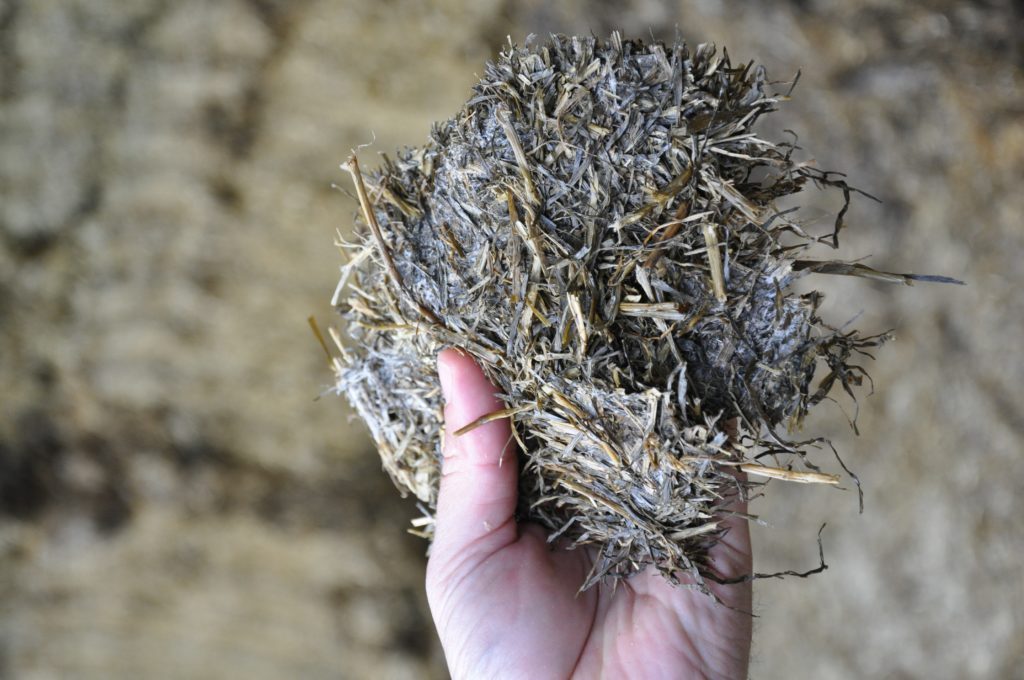Mycotoxin Risk with High Dry Matter Silages
11 October 2018Grass silages on average this year are much higher in dry matter and protein and slightly lower in fibre, which means intake potential is up to 15% more than that of last year. However, with the higher dry matter there will be an increased risk of moulds and mycotoxins due to the higher pH and silages being less stable. The table below shows a comparison of dairy grass silages analysed by SRUC in both 2017 and for the 2018 season.
Moulds which commonly grow on grass silage and other wet feed stuffs can often produce mycotoxins which can be detrimental to health as well as performance. Monogastric animals tend to be more susceptible to the effects of mycotoxins in comparison to ruminants. However, freshly calved dairy cows with high feed passage rates and those under metabolic stress may struggle to deactivate them in the rumen.
Conserved forages with a pH of 4 or less are considered fairly stable and tend not to encourage the growth of mycotoxin producing moulds. Looking at the average dairy grass silage so far in 2018, the pH is 4.4, highlighting a potential risk of mycotoxins being present in higher levels within dairy rations this winter. Good clamp management is essential to reduce the risk of spoilage on the clamp face with high dry matter silages. Farmers should aim to move across the clamp face in no more than two to three days, keeping it as clean as possible by using shear grabs or block cutters.
Mycotoxins within the rumen can have major effects on the rumen microbes, ultimately reducing feed digestibility, which subsequently will reduce available nutrients for milk, body condition and/or reproduction. Therefore reductions in milk yield can be seen along with lower butterfat percentage. Suboptimal conditions within the rumen can cause reduced feed intake leading to further reductions in performance. Metabolic diseases such as ketosis and displaced abomasum can also occur due to poorer rumen function. Further along the digestive tract mycotoxins can cause inflammation and damage tissue resulting in scour.
Mycotoxins have been found to supress immunity making cows more susceptible to diseases including mastitis, metritis and laminitis. Aspergillus fumigalus is a common mycotoxin producing mould found on conserved forages and it can cause pneumonia as well as mastitis and abortions. Diseases from suppressed immunity are often seen more in early lactation cows as they already have a naturally suppressed immune system.
Hormonal processes can be affected by mycotoxins and potentially alter reproduction. Mycotoxins can cause poor conception rates, cystic ovaries, embryo loss, abortion and infertility. In addition, udder oedema, as well as swelling of the legs and hocks are also commonly seen where the mycotoxin load in the diet is high.
A wide range of products are now available on the market for using in situations where mycotoxin risk is high. These should always be used in accordance with the manufacturers recommended rates and alongside a well formulated ration. Where mycotoxins are a real risk, rations should include antioxidant nutrients as well as buffers to ensure good rumen function.
Mycotoxin binders can reduce the level of specific mycotoxins within the rumen thus reducing their overall affect. Binder effectiveness depends on the chemical structure of the mycotoxins present. Therefore some mycotoxins such as aflatoxins are easier to bind than others due to their flatter chemical structure. When buying a binder, clay based binders should be avoided as they can bind minerals and vitamins. Aim to use a broad spectrum binder which is fast acting and scientifically proven.
Sign up to the FAS newsletter
Receive updates on news, events and publications from Scotland’s Farm Advisory Service


